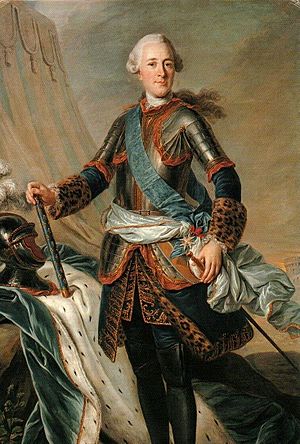Charles de Fitz-James de Fitz-James, 4th Duke of Fitz-James facts for kids
Quick facts for kids Charles de Fitz-James |
|
|---|---|
| 4th Duke of Fitz-James | |
 |
|
| Spouse(s) | Louise Victoire Goyon |
| Issue | |
| Jacques Charles, 5th Duke of FitzJames Laure Auguste, Princess of Chimay |
|
| Full name | |
| Charles de Fitz-James | |
| Father | James FitzJames, Duke of Berwick |
| Mother | Lady Honora de Burgh |
| Born | 4 November 1712 Saint-Germain-en-Laye, France |
| Died | 22 March 1787 (aged 58) Hôtel Fitz-James, Paris |
Charles de Fitz-James (born November 4, 1712, died March 22, 1787) was an important French general. He was the 4th Duke of Fitz-James. His family, the House of Stuart, had royal roots in Britain. Charles became a powerful nobleman and even a Marshal of France, which was a very high military rank.
Contents
Life of a French General
Early Years and First Battles
Charles de Fitz-James was the son of James FitzJames, 1st Duke of Berwick. His father was the son of James II of England, a former king. From birth, Charles was known as the "count of Fitz-James."
When he was only 17, Charles became a governor and lieutenant-general in a region called Limousin. This happened on December 28, 1729. In 1730, he joined the musketeers, a special group of soldiers. By 1733, he was in charge of an Irish cavalry regiment. This regiment was even renamed the Fitz-James regiment after him!
In 1733, a war broke out in Europe. Charles's father led a French army into Germany. Charles fought in his first battles at the sieges of Kehl (1733) and Philippsbourg (1734). A siege is when an army surrounds a city or fort to try and capture it.
Sadly, during the siege of Philippsbourg, Charles's father was killed by a cannonball. Charles was standing right next to him. After his father's death, Charles inherited his title and became a Duke. He continued to serve in the French army until a peace treaty was signed in 1738.
Fighting in the War of the Austrian Succession
Another big war started in Europe in 1740. It was called the War of the Austrian Succession. France supported one side, and Charles joined the fight.
In 1741, he served as a brigadier, a military rank, in a large French army. He took part in many battles during this war. He also helped during the Siege of Prague and the difficult retreat that followed.
After returning to France in 1743, Charles continued to serve in the army. In 1744, he was promoted to maréchal-de-camp. This meant he was a general who commanded a division. He helped lead sieges at Tournay, Oudenaarde, and Dendermonde. He also fought in the important French victory at Fontenoy in 1745.
In 1746, he joined the French army in Flanders. He helped cover the sieges of Mons, Saint-Guilhain, and Charleroi. He also fought in the sieges of Namur (1746) and the victory at Rocourt.
The Battle of Lauffeld in 1747 was a very bloody battle. The Duke of Fitz-James fought there. He also helped with the Siege of Bergen op Zoom (1747). He was still fighting at the Siege of Maestricht when the war ended in 1748.
Soon after the war, on May 10, 1748, Charles was promoted to lieutenant general. He also became a peer of France and was given special honors by the King.
The Seven Years' War and Later Life
When the Seven Years' War began, Charles was called back to lead parts of the French army in Germany. He fought in several battles:
- Battle of Hastenbeck (1757)
- Krefeld (1758)
- Lutterberg (1758)
In the Battle of Minden in 1759, Charles was in charge of all the French cavalry (soldiers on horseback). His charge against the enemy was not successful, and the battle was lost.
He returned to France in 1760. In 1761, he became the commander of the Languedoc province. A few years later, in 1763, he had a disagreement about taxes with the local government in Toulouse. This led to some trouble, and Charles had to step down from his role.
However, he returned to public service in 1766. He became commander of Béarn, Navarre, and Guyenne. In 1771, he became commander of the Brittany province. Finally, in 1775, he reached the highest military rank: Marshal of France. After this great achievement, he retired from his duties.
Family Life
In 1741, Charles married Victoire Goyon. She was the granddaughter of a famous French Field Marshal.
Charles and Victoire had seven children. Two of their notable children were:
- Jacques Charles, 5th Duke of FitzJames (1743-1805), who became the 5th Duke of Fitz-James and a French general.
- Laure Auguste de Fitz-James

